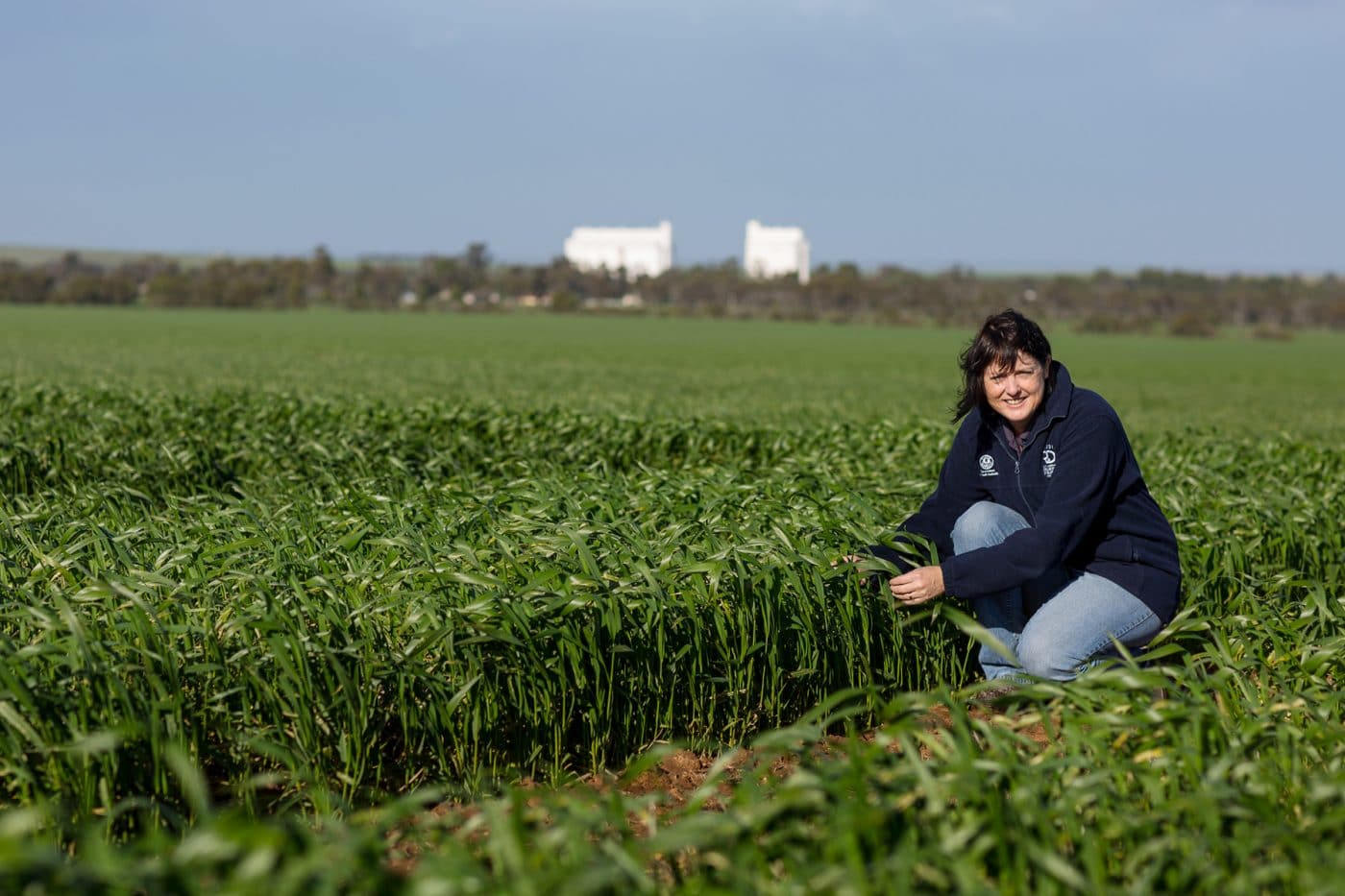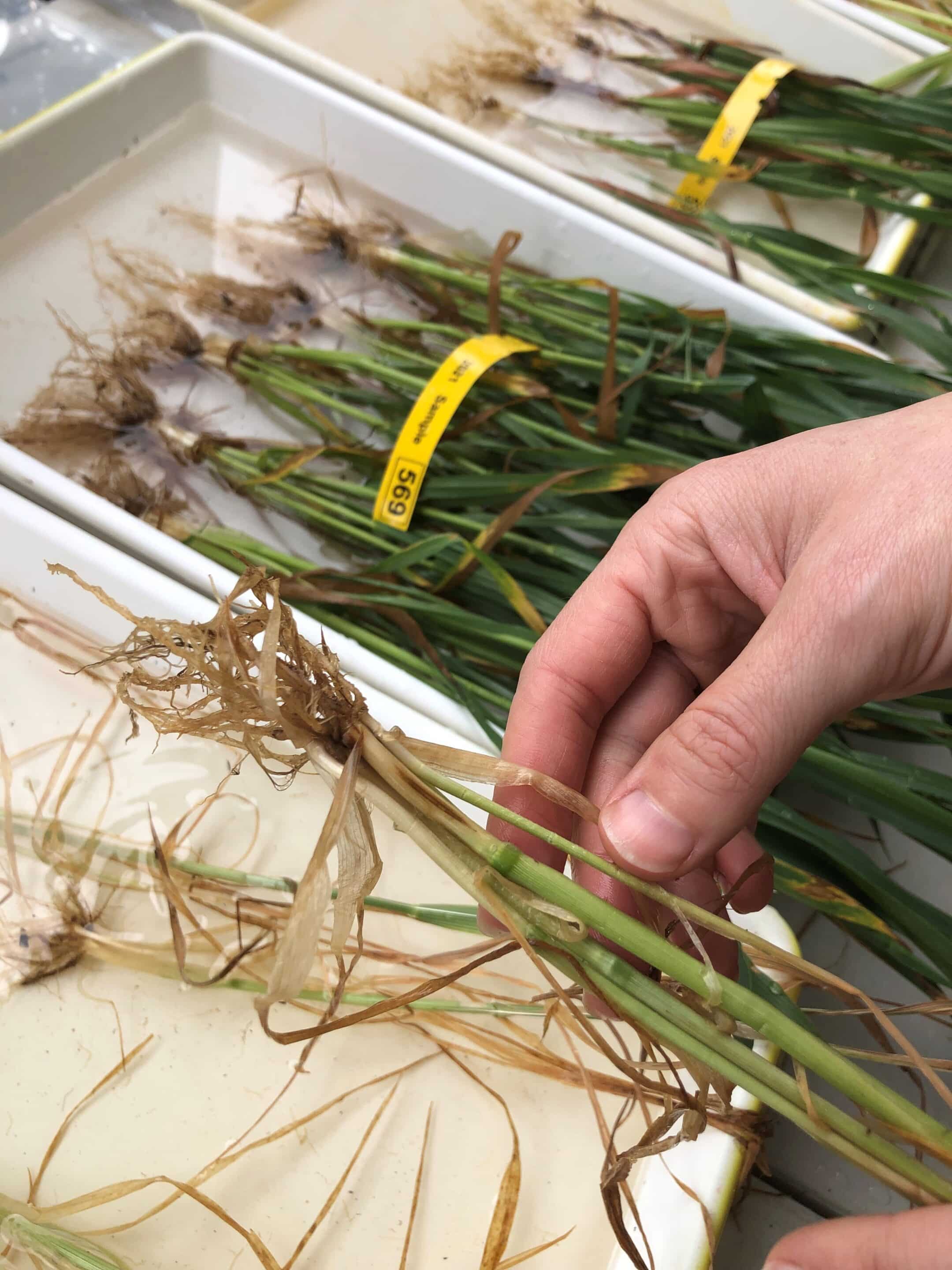START
FINISH

Summary
SARDI demonstrated the combined value of management practices which reduce the impact of rhizoctonia in typical upper EP and Mallee environments.
Background
Research Aims
- Demonstrate the value of ‘best bet’ rhizoctonia management strategies in comparison to current farming practices.
- Examine the impact of break crops on rhizoctonia inoculum and of crop management on disease expression in the following cereal crop.
In The Field
Broadacre demonstrations on the Eyre Peninsula, at Piednippie (near Streaky Bay) and Warramboo, and in the Mallee, at Wynarka, researched methods to reduce the impact of rhizoctonia in farming systems.
Strategies used to minimise rhizoctonia inoculum levels included grass-free break crops in a rotation, such as canola, fallow, vetch and medic, while controlling the green bridge before seeding.
Strategies used to reduce the impact of in-crop rhizoctonia infection included adequate nutrition, particularly zinc and other trace elements, fluid phosphorus fertiliser delivery in calcareous grey soils, sowing depth, sowing time (earlier into warmer soil temperatures) and fungicide use and placement.
Paddock fungicide demonstrations were monitored at Mudamuckla, Buckleboo, Lock and Minnipa Agricultural Centre in 2013.
Results
In 2012 and 2013, rotation options using canola and medic/fallow reduced rhizoctonia inoculum in the following cereal crop, validating previous trial research. At Piednippie in 2011, wheat yields were the same under both rotations. However the gross margin result was higher for the medic/wheat rotation because the variable costs were greater in the canola (see table. For economic analysis, see appendix).
In 2012, rotations of juncea canola (mustard) and medic/fallow resulted in different wheat yields, however the break crop gross margins showed little difference in financial performance.
The lowest rotation gross margin was wheat/wheat compared to the rotations with a break year (see table) indicating the overall production and financial benefits of a rotation with a break when compared to a wheat/wheat rotation.
Modelling was used to determine the break-even yield for canola in lower rainfall environments. A yield of 0.36t/ha is needed to be financially equivalent with a medic/wheat rotation, given average seasonal conditions. A long-term yield of 0.45t/ha is needed to provide a profitable risk-reward and should be considered as the necessary canola break-even yield.
Fungicides
Performance of new fungicide products released in 2013 for rhizoctonia suppression was variable. Some products performed only marginally better than the controls.
At Warramboo, the fungicides used produced significantly lower rhizoctonia patch score but not lower rhizoctonia root infection. The economic evaluation showed the selection of fungicide was important when evaluating yield and input costs. The cheaper EverGol Prime gave an improved gross margin due to an increase in yield and lower input costs, while the use of Uniform gave minimal improvement in gross margin over the control despite an increase in yield.
At Wynarka, there were no differences in plant growth, rhizoctonia seminal or crown root scores, grain yield or grain quality between the control and the fungicide treated crops. While there was some gross margin improvement when using fungicides, this financial improvement was minimal when comparing the three year rotational gross margin.
Banded in-furrow fungicides were more effective than seed treatments, and new products at higher rates were also effective. Yield responses to fungicide treatments in both wheat and barley occurred however visual rhizoctonia patches were still present in treatments. Tillage, starter nitrogen and zinc produced similar yields to many of the fungicide treatments.
Most treatments in the barley trial gave no significant gross margin improvement when compared to the control. Only one fungicide treatment produced an improved gross margin above the control treatment ($345/ha).
A survey of EP and Mallee growers found they consider rhizoctonia when making planting decisions, and the use of break crops, fungicide and green bridge control, to manage rhizoctonia had increased.
Project Participants
SARDI: Amanda Cook, Ian Richter, with support from Vadakattu Gupta, Alan McKay, Kathy Ophel-Keller, Nigel Wilhelm, Paul Bogacki, Bill McLeod, Daniel Huberli and Sjaan Davey; Dodgshun Medlin and Mike Krause.
The Problem
There are a number of different strategies for reducing rhizoctonia inoculum. However deciding on the most efficient and cost-effective strategy can be difficult.
The research
SARDI conducted trials looking at best bet strategies for rhizoctonia management.
More information
Amanda Cook, SARDI Research Officer
T: 08 8680 5104
E: [email protected]
Value for Growers
- Grass-free break crops such as canola, juncea canola, medic and vetch are the best options to lower rhizoctonia inoculum levels, allowing other weed control options, earlier sowing opportunities and higher yield for the following cereal.
- Vetch/wheat rotation (compared to medic pasture/wheat) gave the best financial result.
- Low input vetch lowered rhizoctonia inoculum levels similar to medic, and provided a gross margin improvement of $100/ha.
- Oilseeds proved to be a financial risk compared to medic in low rainfall regions, particularly in a poor season.
- Lower cost fungicide products provided a better economic benefit in farm demonstrations. Economically the yield responses were positive on wheat but not on barley and the lower cost options performed well economically despite not
achieving the highest yields. - A rhizoctonia risk decision-making tool has been developed to help farmers evaluate cereal root disease risks based on previous crop rotation, management decisions, timing in the cropping season and environmental conditions and will be available on the EPARF website.
Latest Research Projects



